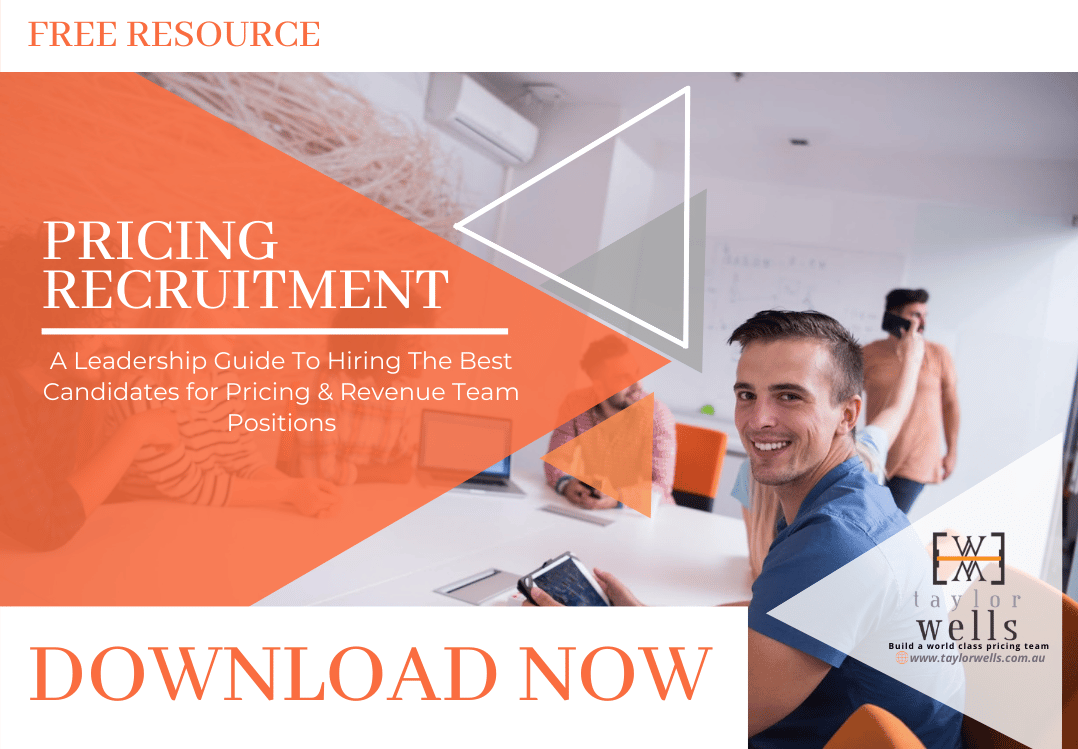
Time and time again, Australian organisations are unable to appoint the right person to key decision-making roles. Taylor Wells believes that the answer is better pricing recruitment, one that aligns an individual’s technical skills, soft skills and underlying values and motivations and those of the organisation (including the team they are joining).
>Download Now: Free PDF Pricing Recruitment
Many businesses choose the best person at the time rather than the best person for the job. Little care and rigour are taken with internal mobility and promotion.
A large majority of staff are moved into new roles with little to no evaluation of their suitability and fit for the new role and team. As a result, we find that too many talented people are being overlooked for roles they’d be absolutely perfect for because of an unstructured and largely subjective hiring process.
In short, we are finding that…
Years of sub-optimal pricing recruitment has permitted unsuitable placements into key roles. Now, as a consequence, we are all coping with a proliferation of worrying workforce challenges largely created by bad hiring decisions and processes.
Table of contents for this article include:
I. Pricing recruitment: Take control of recruitment and test before you hire
II. Effective Pricing Recruitment: CVs Are Messing Up Hiring Pricing Teams!
III. Pricing Recruitment Strategies: Build Leading Recruiting Strategy & Social Media
IV. Pricing Recruitment Automation Can Drive Pricing Talent Away
V. Commercial Recruitment: Bad hiring costs Aussie economy $54.8bn per annum
VI. Pricing Recruitment Costs: Recruit Like Google Without Spending Big Bucks!
VII. Pricing Recruitment System: Next Generation Recruitment Is Hype & Not Substance
Capability Building Programmes For Pricing & Sales Teams!
Pricing recruitment: Take control of recruitment and test before you hire
Following on from a recent story in the Financial Review (Headhunters slammed over conflicts), which demonstrated how recruitment agencies are failing to vet executives properly), this article discusses the importance of using pricing and commercial assessment to screen executives for niche, complex and difficult to fill pricing and commercial roles.
How Many Pricing Analysts Do you Really Need? 👩💼 Podcast Ep. 40!
The story below is told to you by a senior business manager of a Fortune 500 corporate services company; and discusses their journey to using pricing assessments to building a more effective commercial function through price recruitment.
Pricing Recruitment For Pricing Managers!
Price recruitment – using a structured approach
“Testing can sometimes seem too much hassle and too time-consuming prior to bringing onboard a new employee. However, I have been stung in the past and once bitten, twice shy rings the old refrain.”
It is often thought that pricing competency testing is most appropriate for more senior roles. In my experience, competency-based testing is indispensable and very easy to administer for Business Analyst or Pricing / Commercial Analyst roles (see pricing manager job description). To get the maximum out of a pricing manager or pricing professionals generally, of course, they should be resourced with a competent analyst.
In a previous role, I required a Business Analyst and honestly felt I could not delay in hiring one. I was snowed under and needed someone to lift the data-heavy work of my plate a bit. I met a number of strong candidates and settled for a very intelligent, smooth-talking and well-presented analyst. When asked about his Excel, Word and analytics skills he gave all the right answers.
Two months later I was struggling to understand how this employee continued to under-deliver even on simple tasks. The penny dropped for me when I suggested he try a pivot table as a quick way of filtering data – he asked: “What is a pivot table?”
Thankfully, as is often the case, he resigned before I made a final decision on his employment.
〉〉〉 Get Your FREE Pricing Audit 〉〉〉
Customised an online pre-employment screening test
For the next candidate, I engaged the Taylor Wells team. They managed the price recruitment process for us and customised an online pre-employment screening test so that we wouldn’t have to waste our time trolling through CVs and/or wasting time interviewing the wrong people. This assessment covered all the skills and behaviours we needed for this role. It included: word documents, PowerPoint, financial modelling, excel analytics, business math and formula, pricing basics etc.
Real-time analytics and monitoring of candidates made it possible for us to effectively grade and pass or fail the candidates. Through this process, I was able to effectively filter the candidates and have only shortlisted successful candidates who I knew had the vital skills, competencies and attitude to do the job well. I could even see which candidates showed a natural aptitude for quantitative pricing analytics and which were more suitable to the qualitative value proposition and customer insight work.
Another unexpected side benefit of the Taylor Wells program was that it highlighted the weaknesses of an internal candidate. This candidate came highly recommended by the CFO. Without the brief exam (which he scored very poorly on) I would have found it difficult to reject this candidate.
My advice is to test before you hire to get the right team.”
Capability Building Programmes For Pricing & Sales Teams!
Effective Pricing Recruitment: CVs Are Messing Up Hiring Pricing Teams!
Why do we continue to use CVs to make technical hires in emerging functional areas we know relatively very little about rather than utilise more effective recruitment approaches?
I get that CVs provide a neat summary of professional experience, which is important and useful when you are comparing candidates. I understand that CVs tell us a very important story about someone’s life. They help us understand how someone’s arrived at the place they are today – again extremely important and useful information when weighing up suitability and fit.
How Many Pricing Analysts Do you Really Need? 👩💼 Podcast Ep. 40!
Unfortunately, though, many CVs don’t tell us the real story about someone’s life, and professionals skills and experiences are often embellished and hence are not effective recruitment tools. Some CVs are phoney, and others create a false impression about the depth and breadth of someone’s skills, competencies and passion for pricing and revenue management. There have also been increased issues with identity theft due to social media etc.
People know that good CVs win more interviews. They know recruitment tracking systems and recruiters are screening for keywords. Many candidates develop their CVs and LinkedIn profiles using popular keywords to get more attention, views, job enquiries, callbacks or interviews. How often have you sat through commercial recruitment interviews and been amazed that the person your meeting, its nothing like you imagined from their CV? I bet you have both good and bad experiences.
CVs are ineffective ways of predicting high performance in pricing teams and not always effective pricing recruitment
Effective recruitment and talent recruitment competition has turned into a game; people know that a good CV will help them win a great job. Many applicants have professional writers develop their CVs. What you see on paper is not necessarily what you get in real life – and this is becoming the new norm in recruitment.
In fact, our research shows that a CV is a completely ineffective predictor of character and individual pricing capability.
Our research on pricing and revenue management teams finds, for instance, that highly capable pricing leaders and managers tend to be more self-critical and rate their skills slightly lower than their actual capability and the opposite is true for underperformers. The same goes for high potentials.
A CV does not tell you how good a pricing manager is at solving pricing problems and tackling wide-scale change initiatives. Often great pricing managers don’t know how good they really are because they have nothing to compare to. Just because it says on their CV and LinkedIn profile that they are good at pricing, a team player and a great people manager, doesn’t necessarily mean they are.
Replace CVs with real proof & evidence
To know how good someone is at pricing or revenue management or even people management, you need to see them in action? Get proof. Use evidence-based hiring. See how they think through problems; react to challenges; reason through data; respond to pressure.
To hire pricing superstars, we need to stop relying so heavily on CVs and also AI recruitment and begin to understand the basic attributes that lead individuals to make good or bad pricing decisions.
What constitutes domain pricing expertise
We need to understand what constitutes domain pricing expertise and measure individual pricing capability. We need to compare candidates using objective and relative benchmarking data rather than gut feel and internal benchmarks.
As time goes by, internal recruitment functions are doing less, and less real screening and HR managers are doing less, and less scientific investigation of high performance.
We have all become too pre-occupied with administration and lowering costs by outsourcing complex recruitment interaction to computers.
We are seriously underplaying the need for good recruiters and talent managers to read and interpret higher-order cognition and emotional interactions during the hiring process. Complex interactions like reading someone’s: motivations, drives, intentions, commitment levels, value system, thinking style, behavioural style etc.
The irony in all of this is that recruiters actually want to do better work and improve their analytical skills. And, likewise, candidates want to have the chance to prove themselves beyond their CV or job application.
Pricing Recruitment For Pricing Managers!
Conclusion
- The current recruitment process dis-empowers both parties and makes everyone dread recruitment. All this needs to change
- One company’s A player may be another company’s B player
- There is no 1 CV out there that defines a successful pricing person; there’s is, however, a science to bringing together the right team mix so that individual’s and teams alike succeed
- The best recruiters of great pricing people understand the individual, team, function and the business during the hiring process, including the root pricing problems you have to solve (and even the opportunities available)
- Great recruiters want to understand a candidate’s approach to problem-solving because they know decision-making capability is much more important than previous experience
- A great recruiter also knows how someone goes about their daily life is just as important as their abilities and skills
- We all have skills, capabilities, potential and even derailing behavioural traits that cannot be measured or described in our CVs. Very often people don’t even know what they are really good at
- A CV says nothing about how we perform best, only what we are likely to perform best in – and even then this is a matter of opinion
- Without a better understanding of what’s really driving high performance and lack of performance in pricing and revenue management organisations we are destined to repeat failure and not effective recruitment, and continue to pay the high cost of that failure
- The strengths and skills written down on someone’s CV are really just an illusion or projection. A great match is what really matters for effective recruitment for pricing roles
〉〉〉 Get Your FREE Pricing Audit 〉〉〉
Key learning for hiring managers and effective pricing recruitment:
The key hiring questions we’ve got to ask ourselves, then, is:
- What is it that shapes and influences this person?
- Does it align with what we believe as an organisation?
The mindset that we are what we have lived is incomplete, i.e., our past, our experiences.
A candidates CV biography is not their destiny. Their self-concept (what we think of ourselves) is a projection.
The past does not equal the future – or maybe it does it you live there.
Making great hires is about recognising great matches, not great CVs.
But often the best matches are made by great recruiters, not algorithms. i.e., the people who care enough to examine the person behind the CV. The people who select based on how well individuals can help accelerate a culture the business wants to see in the next 2-5 years.
The decisions we make shape cultures, CVs don’t.
Capability Building Programmes For Pricing & Sales Teams!
Pricing Recruitment Strategies: Build Leading Recruiting Strategy & Social Media
The Australian market is changing rapidly. Unlike any time before us, we see more businesses and candidates making life-changing decisions based on social media recruitment strategies and information.
The Australia talent market is highly informed and highly influential: A two-sided market that shares feedback and insights on social networking sites to get the low down on future employees and potential candidates to learn about the culture.
At the same time, the recruitment strategies (see agile recruiting) are drowned in a noisy market: There’s huge amounts of chatter and conjecture out there in social media land, yet very little evidence and substance.
The Internet is full of social media avatars that all seem like good potential matches to roles fitting your recruitment strategies on face value.
Introduction to Value Culture 💡 Podcast Ep. 96!
But there is no depth; no validation tools; no evidence; just lots of faces and stories.
Social recruiting draws on an online world of projections – social media avatars that are one step or maybe 3-7 steps removed from the person constructing their social media identity.
Social media and effective pricing recruitment strategies
The Internet of Smoke and Mirrors (IFM) is perpetuating greater uncertainty and confusion in the Australian and Global Talent market rather than resolving it: We have got into the habit of validating our hiring preferences and decisions using secondary online references that echoes back what we want to see, hear and learn about ourselves and someone else.
Social Media recruiting is ultimately trading access for our personal data and privacy. Identities and interactions are now strewn across hundreds and thousands of databases, networks and systems until a reminder, tag or alert awakens a use and importance for our personal data.
Our individual capability and what makes us truly unique and special now morphs and changes with what’s trending in real-time. Our depth, complexity and memories are clouded by false identities and projections based on aggregate population statistics and preferences.
Through social media recruiting we may have unlimited access to lots of information and data about each other, but we have lost quality control and focus: i.e., there’s not enough filters, checks and processes to make sense of information and data.
We are exposed to risk and latent biases. Many of us have handed over the responsibility of candidate selection and recruiting for our pricing department to individual hiring managers and now computers hoping they’ll know what to do. Unfortunately, over 80% of hiring managers overlook important characteristics during candidate interviews and/or tend to hire people like them when they use social media sites.
Top HR challenges with Social Media Recruiting
For many years now, we’ve been told that “getting social” will help us 10X our recruitment strategies, hiring, performance, results and human interactions at work.
But, I’m not so sure: Corporate transformations still have miserable success rates, and recruiting practice is still as rotten and broken as it always was.
We were assured that Social Media Recruiting would significantly improve our understanding of people, change, and hiring. However, sometimes it seems as if social media has created greater depths to an already sullied recruiting dilemma…
Our research shows approximately 85% of the factors that impact strategy and implementation either partially or entirely concern talent and culture.
What’s more, contrary to what social media sites hypothesised many years ago; many of our people and recruiting dilemmas are not really about efficiency and access to data, they concern quality control and fundamental shifts in thinking.
In short: The only way we are going to transform is by changing how we view the world and ultimately what we choose to filter out.
So, let’s start now and remove the social media filter and begin to view the Australian talent market a little differently…
Pricing Recruitment For Pricing Managers!
Social recruitment strategies aren’t easy for anyone concerned, and the opportunity cost of not re-thinking recruitment in a social media-led talent market is huge:
- Disengagement starts during the recruitment process or even before new people officially join the business
- Social media filtering is an ineffective way of removing people from a hiring process and the worse aspect of the AI talent algorithm
- Social media profiles are not real and need to be validated
- Misinformation is a big problem and needs to be addressed
- Social media sites do not challenge your view but echo back what you want to hear
- Social media create serious diversity issues and biases with a filtering system optimised to draw our attention to appearance, name, educational background and ethnicity, and unvalidated skills and feedback
〉〉〉 Get Your FREE Pricing Audit 〉〉〉
Conclusion on pricing recruitment strategies
As the influence of social media continues to increase, Taylor Wells advise both candidates and companies to carefully evaluate one another using more rigorous and scientific filters, checks and processes.
We also strongly recommend that businesses use evidence-based recruiting to hire the right people for the right roles if you are sourcing people through social media sites.
It is possible to have a highly personalised and automated candidate selection process running concurrently with social media recruiting if you know-how.
Capability Building Programmes For Pricing & Sales Teams!
Pricing Recruitment Automation Can Drive Pricing Talent Away
More high calibre people are abandoning recruitment processes in the early stages of recruitment than ever before – i.e. due to the short-sighted recruitment automation.
Most job seekers hate recruitment automation processes because they deliver such poor candidate experiences – long online job applications (see agile recruiting) and meaningless rejection and feedback emails do not incentivise smart people to carry on with the recruitment process.
How Many Pricing Analysts Do you Really Need? 👩💼 Podcast Ep. 40!
Can pricing recruitment automation replace real human insight?
The American Staffing Association 2017 candidate survey finds that over three-quarters of respondents preferred some human interaction in their job search.
Yet, at time goes by, more businesses invest in AI-driven software tracking systems. This means all of the important people elements that bring value to the process end up being removed from a recruitment system.
Businesses may think they are cutting costs by recruitment like this, but in actual fact, they are driving people away and extracting all the value out of recruitment.
Our research shows a staggering 88 percent of job seekers found heavily recruitment automation processes, frustrating, especially if they never hear back from employers about the status of their online applications.
Pricing Recruitment For Pricing Managers!
A Corporate Executive Board report shows:
- 95 percent said technology should be used to assist the recruiting experience, not replace it
- 87 percent said technology has made looking for a job more impersonal
- 82 percent said the ideal interaction with a company is one where innovative technologies are used behind the scenes and come second to personal, human interaction
If culture eats strategy for breakfast, as Drucker says, then why aren’t more corporate leaders paying closer attention to the abandonment of applications on the company’s ATS (applicant tracking system) portal to assess culture?
Engagement levels during the recruitment process is an excellent measure of culture and brand perception, yet very few companies use this data.
Good recruiters increase engagement figures because they offer candidates relevant performance feedback, advise on suitability and provide insight in the process, the role and culture.
Too much technology with too few recruiters and talent managers will hurt the recruitment and assessment process. Cutting costs by removing vital human recruiters will only lead to a lower number of good applications and retention issues further down the line.
The question HR really needs to ask is: Why are we investing in expensive recruitment software to automated broken processes and high volume recruitment when the future of work means fewer jobs across the board?
AI has impacted all areas of business. Automating task-based work across accountancy, mathematics, medicine, pricing, recruitment and architecture.
AI will eventually remove low leverage jobs which ultimately constitute the bulk of all jobs.
Businesses will no longer have the problem of sifting through thousands of CVs and applications anymore because these roles will no longer exist. So why develop volume recruitment automation processes? Makes no sense.
〉〉〉 Get Your FREE Pricing Audit 〉〉〉
Conclusion
- The truth is AI will remove most jobs and create fewer new and more challenging roles
- Job transformation is already occurring in pricing and revenue management and it’ll occur in HR too
- The nature of recruiting is changing no matter how much we delude ourselves
- Next-generation recruitment will require recruiters to be a hybrid of coach, data analyst, design thinker, marketer and storyteller
- I call this evolved position the talent manager
See a Tedtalk video below on how people can find jobs they actually are passionate about:
Capability Building Programmes For Pricing & Sales Teams!
Commercial Recruitment: Bad hiring costs Aussie economy $54.8bn p.a.
Commercial recruitment: Bad hiring practices are facilitating a serious workforce malaise in Australia – a malaise of disengaged, depressed and under-skilled workers. It is costing the Australian economy about $54.8 billion a year, according to a Gallup workforce report.
How Many Pricing Analysts Do you Really Need? 👩💼 Podcast Ep. 40!
Commercial recruitment – how to avoid the common pitfalls!
In this article, we will discuss how:
- Incorrect commercial recruitment impacts culture & profitability
- Bad hiring disconnects leaders from their people
- Bad hiring is subjective hiring
Very few companies intentionally work to improve their hiring process – in fact, many companies just leave hiring to the last minute or rely on standard process. Recognising bad or outdated hiring is the first and most important step in changing how you hire to create a culture that you want to see.
Incorrect commercial recruitment impacts culture & profitability
We find ourselves headlong in an era of workforce disengagement. An era defined by a task-based workforce that lacks energy, skills and drive to succeed and/or who are visibly stressed, bored, burned out, disengaged, unhappy and unproductive.
- 80% of employee turnover is due to bad hiring decisions (source: Human Resources society)
- 75% of employees think their direct line manager is the worst part of their job
- 65% would happily take a pay cut if they could replace their boss with someone better
- Only 19 % of managers in Australian businesses are genuinely interested in their jobs while the rest were either not engaged or actively disengaged
(Source: Gallup report).
Not hiring the right way is seriously impacting organisation health and profitability. According to a CareerBuilder survey, a bad hire can cost from $25,000 to $50,000 or more and this was back in 2012.
US businesses report losing $450B – $550B in lost productivity every year.
Too many people are accepting jobs and not positively contributing to the business. Too many companies are regretting not paying enough attention to how they recruited people into key roles.
Bad hiring disconnects leaders from their people
Bad hiring is widening the chasm between leaders and their people. Even new hires are quickly disengaging from the business. 40% of managers hired from outside the business leave or are fired in the first 18 months even though businesses need new skills and knowledge to improve decision making.
Many new recruits say that the role was not as the interviewers described in the job interview. Others have difficulty adjusting to existing culture norms (or low-performance standards).
Frequent employee complaints include poor executive leadership; limited remit and authority; silo-ed decision making; infighting among team members; and bureaucratic sign off procedures for even the most basic decisions.
Within a few months, new hires are becoming hardened to bad cultures. This often manifests in a self-centred or headstrong approach to getting things done and/or a strict focus on the immediate.
A mindset based on self-preservation delays your business culture. People become more pre-occupied with keeping their jobs than they are about achieving collective goals.
Limited career pathways and opportunities
Years of cost-cutting and headcount reductions have limited career pathways and opportunities. Good staff are becoming bored and restless in businesses with limited opportunities. Candidates or potential employees are getting scared off by roles that only bring challenges and no rewards.
Even talented new teams are struggling through day by day. Many new teams are complaining that there are still not enough people on the team or in the organisation with the right mix of skills, personality or energy levels to achieve the results you expect from them.
Companies are struggling to tap into the diversity of skills in their own organisation let alone external talent networks during the hiring process. Budget cuts have ultimately made recruitment a transactional experience and this is widening the skills gap (and giving businesses a bad reputation).
Bad hiring is subjective hiring
A study by Leadership IQ found that 82% of managers admitted having overlooked the importance of interpersonal skills, let alone understanding someone’s values and motivations during the hiring process.
This is not good enough. Transactional hiring is creating more diversity issues than it is correcting. Businesses that rely on traditional recruitment methods tend to hire the same types of people – i.e., people that are like the hiring manager or who the hiring manager like.
Subconscious biases limit the diversity of thinking in your teams. Team dynamics suffer; creating limited cross-fertilisation of skills, personality types, backgrounds and from both genders and at all levels of the business.
Creating real diversity is not that simple
Recent research has shown that singling out under-represented groups on job descriptions can make people feel singled out or threatened. Creating real diversity is not that simple.
An over-reliance on intuition at the expense of scientifically valid and relevant selection tools is a major contributing factor to the growing number of bad hires, team and workforce issues.
Even when hiring managers are good at assessing individual talents during the hiring process (e.g., their skills, expertise, and generic capabilities), they forget an essential element of high performance is strong alignment between an individual’s technical skills, soft skills and underlying values & motivations and those of the organisation (including the team they are joining).
Unwillingness from hiring managers
Sadly, there is a certain unwillingness from hiring managers to give up their much-loved hiring approaches even though they are inadvertently hurting themselves and their team by not challenging their ‘better judgement.’
Many managers do not want to learn new perspectives, believing that their gut and judgement can defy the odds and bypass natural cognitive biases, stereotypes, conditioning and prejudices.
Too many managers assume that when someone is good in a generalist role, they will have the learning agility to be good in an analytical role. This is not necessarily the case.
Different roles require different behavioural profiles, skills and knowledge levels. Expecting staff to perform well in analytical roles without the right tools and skills is setting them up to fail.
One-third of managers say that a lack of experience is a key barrier to filling their open jobs. Most hiring managers are stuck in finding candidates with exact and proven experience of their industry, business operations and role. Little emphasis is placed on the capabilities required to help the business succeed amid changing market dynamics.
Experience does matter when you hire, but what experience matters and does it have to be exactly the same experience as the line managers?
Pricing Recruitment For Pricing Managers!
What needs to be done instead
Intuition and gut feel alone are not enough to predict if leaders and their teams will mesh together and perform. Diversity, equality and fairness thrive when recruitment strategies and processes are based on structured approaches, multiple methods, and robust tools.
Many Australian businesses would benefit enormously from alternative viewpoints and evidence to back their hiring decisions and drive better outcomes for all involved – the business, team and the candidate.
Unfortunately, too many hiring managers don’t see it that way: Many have an overly confident attitude about their own expertise and experience and think they know best. Others dislike utilising more structured approaches and view alternative viewpoints as a slight against their judgment.
〉〉〉 Get Your FREE Pricing Audit 〉〉〉
Conclusion
There is a serious workforce malaise in Australia due to commercial recruitment flaws.
- Too few Australian organisations are able to find the right people for senior, managerial or specialist positions due to commercial recruitment weakness.
- Several newly appointed executives and managers are taking too long to learn and adapt.
- Too many managers and analysts are correctly hired on talent but subsequently fired due to poor culture fit.
Managers with a closed view on hiring tend to have a fixed mindset and need to be challenged to see the potential in people and approach that may subconsciously overlook or avoid.
Hiring managers tend to play the most significant role in influencing engagement among new staff after the recruitment process.
Bad managers are the number 1 reason people leave the business. Bad managers are also largely responsible for creating a toxic work environment and an ineffective recruitment process.
It is essential for Australian businesses to embrace innovative and inclusive hiring to end the workforce malaise and drive a happier, more engaged and productive workforce.
Moving your business forward relies on teams working well together. A good strategy is nothing without good people. Your people are depending on you to build high-performance teams and culture. Great hiring relies on great talent management.
Capability Building Programmes For Pricing & Sales Teams!
Pricing Recruitment Costs: Recruit Like Google Without Spending Big Bucks!
US-based Laszlo Bock, ex Mckinsey and Google SVP of People Operations (or the man behind Googles’ unique work culture) is a firm believer in the power of recruitment to transform work whilst not increasing recruitment costs for businesses.
His mission is twofold: “To make work suck less” as he puts it and to utilise recruitment as a means of accelerating culture change and behaviour.
Laszlo says: “To find the best people for the business you have to be willing to wait.”
High calibre people such as smart price teams don’t just appear when you want them to, he explains. Top talent highly influenced by the quality of job posts and campaigns. If they don’t like your job descriptions they don’t apply. Takes more than an algorithm sourcing and selecting great people. Often there are unexpected recruitment costs.
What can we learn from Google about pricing recruitment costs
What’s more, high-quality people are more likely to abandon poorly run recruitment processes or online applications that fail at seeking talent. They dislike automated recruitment processes and much prefer a high touch recruitment process with real human recruiters that know what they are talking about.
Attracting quality people can be a problem and can entail high recruitment costs, Laslo explains, when you don’t have talent pools, communities or carefully curated talent networks to draw upon. It is important to use a multi-sourcing and selection strategy. Don’t just rely on hiring algorithms.
Case study: Google hiring practice
Google, for example, has publicly discussed its goal to change the demographic makeup of its workforce, which is overwhelmingly male and white or Asian. Yet the 2017 edition of Google’s diversity report shows that Google is finding this a challenging task: only 2 per cent of its staff are black, 3 per cent Hispanic, 75% of leaders are men, and 20% of tech staff are women, but 48% of no-tech staff are women – pointing to the challenges of changing workforce demographics and recruiting by numbers.
Recruitment costs and times have increased by 26 days per recruit compared to 10 years ago according to the Corporate Executive Board.
Businesses that do not have quality talent pools wait for two or three times longer than businesses with qualified talent pools to find high-quality people for pricing roles. The average time to fill a role for organisations using their internal recruitment function or agency to fill is 63 days.
Without a candidate pool to source more specialised talent (or buy-in from the executive team), most businesses time to fill price leadership roles increases to 200 days or more, which is 28 – 30+ weeks or over 6 months to fill leadership or technical pricing positions.
Algorithms cannot ensure diversity
Algorithms cannot ensure diversity or even faster recruitment processes, Bock explains. Businesses relying solely on algorithms face serious diversity and resource issues; even if the organisation has broad buy-in for diverse hiring. There are many recruitment factors that algorithms alone cannot compensate for – such as a homogeneous pool of applicants.
Bock explains businesses have to work much hard than ever to attract the attention of talented people. More often than not, high calibre people are not looking to change roles, they are happy in their current positions, or they haven’t even considered working for another business – it’s just not on their radar or they’re not that fussed.
Google takes candidate engagement very seriously; constantly testing and trialling multiple people and sourcing strategies to find the best matches for them.
They take a 2-3 year view of candidate engagement and actively build high-quality talent pools using thought leadership, marketing, prompts and reminders.
They run and monitor multiple campaigns and engagement strategies to see what strategies work to draw people to them.
Systematically weed out poor matches and inauthentic social media avatars with puzzles, challenges and problem-solving exercises.
“A bad hire can be toxic,” Laszlo explains. “Use recruitment to set the bar high, never compromise on quality, and find someone who is better than you in some meaningful way. Then you’ll end up with a much stronger team.”
A bad hire may be a toxic employee who poisons the morale of the whole team; a bad boss who micro-manages the team or a yes man or women that keeps perpetuating bad habits because it’s safe and easier to acquiesce to the lowest common denominator.
Bad hiring effects
Bad hires negatively affect stakeholder relations and are one of the main reasons high performers leave businesses.
For Lazslo Bock, eliminating bad hires is key to his role at Google as VP of People operations. Bock sees initial search and screening phases as the best place to vet and qualify applications for suitability and fit.
Bock says “We try hard to not look for people who look like us. Rather, we try to find someone different, offbeat, who can push and challenge the status quo.”
We are all inherently biased to hire people like us. Unfortunately, most companies hire to type, creating serious diversity and inclusion issues further down the line.
Bock says, “Before you start recruiting, decide what attributes you want and define as a group what great looks like.”
He adds. “A good rule of thumb is to hire only people who are better than you.”
Developing hiring criteria
Develop a clear hiring criterion underpinned by a proven framework; is the basis for an objective search and selection process. Seeking management alignment on the framework across the hiring committee and clearly defining underlying traits and capabilities helps businesses. Like Google avoid biased hiring decisions and costly hiring mistakes.
Avoiding bad hires and overlooking talent, Bock says, he built a sophisticated search and selection infrastructure for Google that results in every application. Sourced by AI-driven search algorithms, campaigns or referrals to go through to a secondary screening process led by a human recruitment team.
“Google only hires several thousand of the 2 million applicants they receive. This makes “Google 25 times more selective than Harvard, Yale, or Princeton.”
Google has invested in a recruitment team devoted to reviewing all applicants. That have been sourced and screened by AI-driven recruitment systems.
They invested in an additional recruitment team to review applicants; rejected from the regular process. To show the importance of making unbiased selection decisions.
Google reviews all rejected applications. In case someone potentially valuable missed during the search process; (and hence high recruitment costs that a small business can not take).
So, contrary to what many people assume about Google and how it recruits; Google recruitment sourcing and screening process still remains purposely manual and heavily reliant on skilled human recruiters.
Conclusion
- For Google, the cost of making the wrong hire far out ways the cost of carefully assessing applications
- Carefully screening candidates is the value add service to finding the right match for the business. Automating broken recruitment processes and unreliable data only helps AI to learn bad habits and biases
- AI is a tool not the definitive answer on candidate sourcing or selection
- Google purposely does not fully automate the application screening part to AI for 1 very important reason. AI matchmaking, like human recruitment, can propagate algorithmic discrimination
- Designers and engineers developing algorithms are humans with biases. The input data they select will inevitably bias someone somewhere
- How a developer selects data and constructs variables for algorithms can overlook and even omit the importance of skills. And attributes that a human recruiter may think are important to the business.
Conclusion on pricing recruitment costs
- How designers select data to develop their algorithm will naturally alter how they craft the underlying algorithms
- Human recruitment teams are vital to recruitment processes. Finding a practical synergy between AI and human recruiters is a work in progress. But a worthwhile pursuit when you get the balance right
- AI search algorithms are tools; not the complete solution. It is a mistake to let AI control all matchmaking without putting in place expertise, checks and review processes
- Real human recruitment expertise and AI required to improve quality of hire, cost per hire, candidate fit, candidate experience; and hiring manager partnerships. See our blog on why diversity is vital to price intelligently
Capability Building Programmes For Pricing & Sales Teams!
Pricing Recruitment System: Next Generation Recruitment Is Hype & Not Substance
The next-generation recruitment system approach, like traditional human recruitment, broken and flawed:
The next-generation recruitment system is dressed up to be transformative and innovative, but it’s neither…
We are supposed to be impressed because it’s driven by AI; and supposedly smarter, better, faster than us mere humans.
How Many Pricing Analysts Do you Really Need? 👩💼 Podcast Ep. 40!
However, when you tear away at the surface…
…when you read the senseless techno-speak…
…once you look past the flashy advertising pics of smart robots doing complex math…
…when you examine the investor hype about AI…
You realise that next-generation recruitment is just the same bog-standard recruitment soap opera we have all become sadly accustomed to.
Pricing Recruitment For Pricing Managers!
Is a new pricing recruitment system approach – actually that innovative?
The next-generation recruitment system approach is a red herring for businesses:
- It can inadvertently exclude people that may be a good match for the role when seeking talent.
- It cannot validate whether someone’s social media avatar is authentic or not.
- Automating a large broken recruitment model riddled with bias and errors from all angles.
AI recruitment, like the traditional recruitment model, is very transactional. Built on the same myopic assumption sourcing people; rather than objectively and accurately selecting people is the most difficult aspect of recruitment.
Thinking there is a shortage of talent is incorrect. And the wrong way to view and drive recruitment (thanks McKinsey for starting this insidious business myth).
Thinking recruitment is a numbers game is not the complete story either…
There are actually tons of talented people out there and perfect for your businesses. The real problem is that you just don’t know what good looks like anymore.
Taylor Wells believes that next-generation recruitment system (no matter how you dress it up) is perpetuating hiring failure; not fixing the problem.
Our research shows investors’ money in AI misdirected because of this myth:
- There is an over-supply of people and fewer and fewer jobs on offer.
- New roles are becoming more challenging
- Old jobs and skills are becoming redundant.
- Substantial capability gaps in highly specialised areas like pricing and revenue management.
- Businesses are struggling to position new roles and teams correctly within an organisation
- Business leaders do not have the tools and frameworks to put into operation new organisational structures. Capable of dealing with changing work requirements.
〉〉〉 Get Your FREE Pricing Audit 〉〉〉
Conclusion
The real problem with recruitment system issues is not sourcing or bringing people and businesses together. This was yesterday’s recruitment problem. (Things have moved on; there are already too many people and not enough jobs as it is; a problem only going to continue with AI.)
The real problem with recruitment founded on poor and antiquated principles, models and processes; i.e., selection criteria, assessment methodology and conventional thinking that does not work.
AI recruitment has done little to solve the recruitment debacle we continue to experience as businesses and candidates.
95 per cent of the effort and money spent in the current recruitment market wasted; even with the introduction of AI.
95 per cent of both business and candidate efforts are going on filtering each other, not finding each other.
Over 50% of hiring decisions end in failure and regret. Businesses are still struggling to hold onto to talented people. Quality people keep leaving their jobs. Engagement figures are the worst in working history.
How we recruit and set up our teams blamed for serious organisational health and performance issues.
Reassess the purpose and function of pricing recruitment
It’s time to stop recruiting as we’ve already done. Reassessed the purpose and function of recruitment before we invest any more money into the recruitment tech industry.
Let’s figure out a better answer first before we get engineers to create yet more algorithms that don’t work.
At Taylor Wells talent advisory firm our pricing team skills and capability research recommends making sure HR, IT, and recruiters are involved in the development and continuous re-evaluation of their recruiting technology systems and processes in order to ensure that their recruitment programs are identifying high-quality pricing and revenue management people as intended and not “learning” the organisation’s pre-existing biases.
If you would like more information, then download our free pricing guide or e-book now.
Or, feel free to call me on (2) 91994523
Alternatively, subscribe to Taylor Wells pricing channel now and get an update as soon as a new video is released.
For a comprehensive view on building a great pricing team to prevent loss in revenue,
Download a complimentary whitepaper on How to Build Hiring Capability To Get The Best Pricing Team.
Are you a business in need of help to align your pricing strategy, people and operations to deliver an immediate impact on profit?
If so, please call (+61) 2 9000 1115.
You can also email us at team@taylorwells.com.au if you have any further questions.
Make your pricing world-class!








